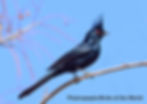Desert Mistletoe
- Mark L. Johnson
- Mar 25, 2021
- 4 min read
Tortolita Alliance reached out to a local expert to learn more about desert mistletoe. Kelsey Yule received her PhD in 2018 from the University of Arizona where she primarily studied desert mistletoe and its interactions with other species in the Sonoran Desert. She currently lives in Tucson, AZ and works with the National Ecological Observatory Network, a project aiming to monitor biodiversity across the continent. Here is Kelsey's commentary.

Desert mistletoe (scientific name: Phoradendron californicum) is a native species that plays a critical and overall beneficial role in our Sonoran Desert ecosystem by providing immense benefits to native animals and other native plants. As an ecologist intimately familiar with both this particular plant and the factors contributing to the health of habitats of Southern Arizona, I strongly recommend against instituting any policies that will lead to broad-scale desert mistletoe removal. I am happy to provide backing peer-reviewed scientific papers for each of the following points, as desired:

(1) Mistletoes are beneficial to birds, pollinators, and even other plants
Many birds and mammals rely on desert mistletoe fruits as a source of food during winter, as the plant produces huge numbers of fruit at a time of year when most other plants are not fruiting.
The native bird species the phainopepla (Phainopepla nitens), depends nearly exclusively on the mistletoe berries. When freezes damage the year’s crop of mistletoe berries, phainopepla populations have been observed to go through precipitous declines as many birds starve.
Desert mistletoe provides a critical food resource for many local pollinators. In fact, in dry winters, locally raised honeybees will feed their young almost entirely with desert mistletoe pollen. Without the pollen and nectar provided by this plant many of our native pollinators, such as solitary bees, would also suffer.
The dense cover provided by mistletoe in the canopy of trees makes it a preferred nesting site for many of our native birds. Without it, predation of eggs and nestlings would likely rise.
Many insects will feed on the green foliage of desert mistletoe, and the beautiful Great Purple Hairstreak butterfly does so exclusively as a caterpillar. The great purple hairstreak, therefore, cannot survive without mistletoe.
It has repeatedly been found with experiments that in plots of land from which mistletoe has been removed have fewer other native species, such as birds and pollinators. Species that are found without mistletoe occur in lower abundance. This decrease in biodiversity can even be found for native plants, as mistletoes contribute to nutrient cycling and, thus, the health of the soil.
(2) The negative effects of desert mistletoe are largely overblown
While they may slow tree growth, there is no scientific evidence that desert mistletoe contributes to tree death, except under extreme drought conditions. Often mistletoes are erroneously blamed for the death of a tree. It is important to remember that all trees die eventually, and some of our desert trees are not particularly long-lived. Desert mistletoe plants are very slow to establish. Each mistletoe plant takes five years from when a seed was deposited to when a single flower or fruit might be a produced. So any tree with a lot of mistletoe in it is likely already very old.
Much of the “bad press” mistletoes receive regarding their effects on host trees are generalizations based on other mistletoe species, of which there are thousands found across the globe, in other situations.
For example, in some regions particular mistletoe species have been introduced to areas and host tree species where they were not originally found. Because those mistletoes were new to those environments, host trees lack defenses and the animals of the region are less likely to use them as food resources. Our desert mistletoe is a native species, so our native host trees have some ways to protect themselves and many of our local wildlife depend on them.
A very different type of mistletoes (Arceuthobium) can be detrimental in the context of forestry industry by causing deformities in the wood. If one’s primary goal is to maximize the quantity saleable timber, removal of those mistletoes is desired. Therefore, mistletoe’s reputation as a pest was formed.
(3) Methods to remove desert mistletoe may not be efficacious and may actually harm the trees you are intending to protect
While chemical products claiming to beat back mistletoe exist, I am unaware of any study supporting their effectiveness at killing the mistletoe or investigating potential harmful effects on the host tree.
Removal of the *visible* parts of the plant is possible by cutting. However, this method is unlikely to kill the mistletoe, which can re-sprout from the same spot within months.
The only way to ensure that mistletoe is dead is to remove the branch on which it grows, a strategy that may cause more damage to your tree than the mistletoe ever could, especially if large branches must be removed.
I see these facts, supported by my own work and that of other researchers, as evidence that community-level mistletoe removal would have inadvertent harmful effects. If an individual dislikes mistletoe on their tree based on aesthetic grounds, removal is something they can explore on their property. However, they and their neighbors may be disappointed to find that removal of this native species on a larger scale has cascading negative effects on other native species that they consider a welcome additions to the neighborhood and surrounding undeveloped land.
Kelsey Yule
